I needed more (optical) power, Scotty!
I recently wrote a review about my new Designs for Vision headlight (my old one broke after over 10 years of service). But, since I was on a roll, I decided to upgrade my DFV scopes, too.
Bigger IS better! Seeing teeth bigger is simply better, almost always. I began my dental magnification odyssey at least 20 years ago. Back then, my eyes were better than 20/20. But, magnification makes your dentistry better regardless of your youthful “perfect” vision. I’ve said before, an astronomer with great eyesight still needs a telescope to see the moons of Jupiter. I started with 2.5x power. Then 3.5x. And, now…. 4.5x.
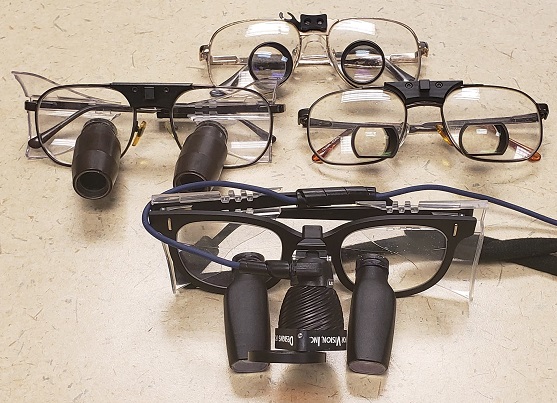
My dental telescope evolution…. BACK ROW: Orascoptic 2.5x. MIDDLE ROW: Designs for Vision 3.5x and Designs for Vision 2.5X. FRONT ROW: Designs for Vision Micro EF 4.5x (and DayLite HDi).
I don’t think I need to beat the “magnified dentistry is better” horse any further. 😀 Hopefully, it is now self-evident.
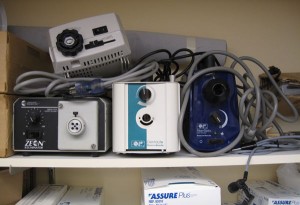
Where dental equipment goes to die. The fiber-optic light box “graveyard” in the supply room. I went through several fiber-optic lights before I switched to an LED headlight (Designs for Vision DayLite).
My first dental telescopes (aka “scopes”) were a 2.5x through-the-lens (TTL) set from Orascoptic. And, they worked well for me. I also got their fiberoptic light, which was a HUGE and loud box. It was the first step. But, I realized I wanted more magnification and a back-up set. I decided to go with Designs for Vision because of their long-term reputation, not just in the dental world, but the medical world. I got two pairs. One was a 2.5x TTL. The other was 3.5x TTL. I also got Designs for Vision’s fiber-optic headlight at the time. I’ve previously written about the value of a headlight, especially with the higher levels of magnification. I feel it is ESSENTIAL. I recently got DFV’s latest DayLite HDi, and it’s fantastic.
Introducing Designs for Vision Micro EF line of scopes!
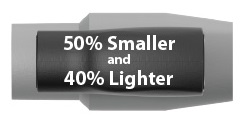
DFV Micro EF lens compared to standard lens of the same magnification power. Courtesy of Designs for Vision.
I’ve been using the 3.5x standard field as my primary scopes for many years now (at least 15 years, I think). My 2.5x scopes are used mostly in the lab or for quick “look-see” types of exams or study model impressions or other minor procedures. As I’ve aged and become more picky about my operative performance, I’ve been wanting more magnification. Designs for Vision recently developed a new line called “Micro EF” scopes. “EF” means Expanded Field. They are prismatic lenses, which allow for higher magnification and a larger field of view in a more compact scope package. So, you get higher magnification and a wider view in a lens that is lighter and smaller…. 50% smaller and 44% lighter, according to DFV.
Oh, what big teeth you have!
I made the jump from 3.5x standard DFV scopes to their new 4.5x Micro EF scopes. I’ll begin simply by saying, “WOW!” The difference in a mere 1.0x (from 3.5x to 4.5x) jump surprised me. While I found the transition from unmagnified to 2.5x very easy, and the jump from 2.5x to 3.5x nearly seamless, I admit that going to 4.5x has taken a bit of “getting used to.” Though, not in a bad way. It’s been fantastic. The clarity and sharpness of the view is CRYSTAL! I see the details of my work even better than before. But, it has taken some accommodation.
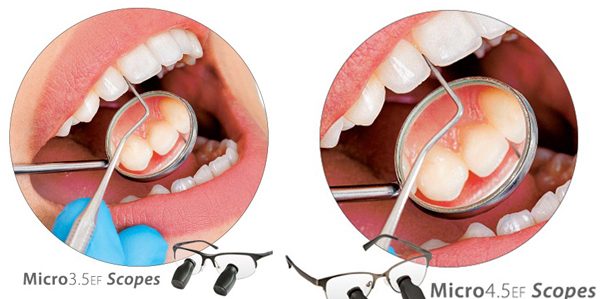
I combined two images from DFV’s website to simulate a comparison of the views between 3.5x and 4.5x.
I fought the Law, and the Law won…
There are some “laws of optics” that come into play as you go up in magnification. First, is that there is less light transmitted through the bigger lenses. Higher mag = darker view, unless illumination is supplemented. At the higher magnifications, you MUST have a headlight. Period. The good news is, you’ll LOVE having a headlight.
The other “law of optics,” as you go up in magnification, is that you have less depth-of-field. Depth-of-field defines what is in focus from objects closest to you to objects farther away. So, with a 2.5x scope, when you’re focused on a premolar, for example, everything from the lips to the uvula are in focus. With a 3.5x scope, while you’re focused on a premolar, the molars and incisors may still be in focus but other structures closer and farther away will be out of focus. At 4.5x, if you’re focused on a premolar, the other premolar and canine may be in focus, but the central incisors and 2nd molars will not be in focus.
At the higher magnification, you’ll need to move your head slightly to move your focus from a central incisor to a molar. I hope that made sense! There’s no way around it. Well, there is… with a camera, you would adjust the aperture (“F-stop”) down to increase depth-of-field, but the trade off is less light transmitted to the sensor (so you have to adjust the shutter speed). I digress. Surgical scopes do not have adjustable apertures, nor should they. I just wanted my readers to be aware of what happens as you go up in magnification with surgical scopes.
It’s not better to look good than to see good, dahlings!
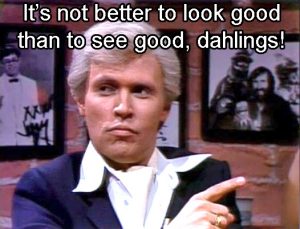 When I got my earlier DFV scopes, I was younger and mildly concerned about the “fashion” of the glasses frames. “Gotta look cool!” Well… as cool as you can be with big, protrusive lenses sticking out of your glasses. I got the more traditional frames that looked “halfway decent.” The iconic DFV “Buddy Holly” frames (aka “Yeoman” model) were out of the question. No way I was wearing those!
When I got my earlier DFV scopes, I was younger and mildly concerned about the “fashion” of the glasses frames. “Gotta look cool!” Well… as cool as you can be with big, protrusive lenses sticking out of your glasses. I got the more traditional frames that looked “halfway decent.” The iconic DFV “Buddy Holly” frames (aka “Yeoman” model) were out of the question. No way I was wearing those!
You can check out Designs for Vision’s wide variety of fashionable frames by clicking here.
Fast forward to age 55…. I don’t care about “fashion!” I care about FUNCTION and durability. So, I went for the Buddy Holly frames with my new DFV Micro EF 4.5x scopes. Oh man, I’m SO glad! I love them! There is a noticeable difference in how they feel on my head. Two words: ROCK SOLID. They really support and distribute the weight of the scopes nicely. I find them very comfortable.
 The Buddy Holly / Yeoman frames are built like the proverbial “tank!” Other frames feel flimsy by comparison. These bad boys will last an entire career! They might look funny, but I’m tellin’ ya…. I’ll use another colloquialism: brick shithouse! 😎 If you’re going big, go Buddy Holly! Ummm… I mean, the “Yeoman” frames. Only the “most confident” dentists will wear the Yeoman’s with pride. 😛 I got mine in the original matt-finished black. But, if you must be “semi-fashionable,” the Yeomans now come in glossy colors! 😆
The Buddy Holly / Yeoman frames are built like the proverbial “tank!” Other frames feel flimsy by comparison. These bad boys will last an entire career! They might look funny, but I’m tellin’ ya…. I’ll use another colloquialism: brick shithouse! 😎 If you’re going big, go Buddy Holly! Ummm… I mean, the “Yeoman” frames. Only the “most confident” dentists will wear the Yeoman’s with pride. 😛 I got mine in the original matt-finished black. But, if you must be “semi-fashionable,” the Yeomans now come in glossy colors! 😆

Getting old sucks! I need readers!
Another consequence of aging is presbyopia (age-related farsightedness). I made it to age 50 without any issues. But now, I need “readers” to focus on anything close up. My first three sets of scopes had blank lenses in the frames, as I did not need any corrective lenses at the time.
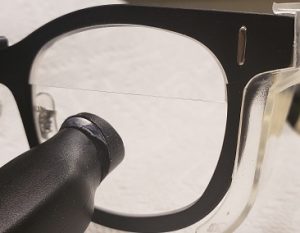
1.75x bifocal “readers” built into the lens. Works great!
When I ordered my new DFV Micro EF 4.5x scopes, I asked if we could put “readers” in the lenses. “Certainly!” was the answer. So, they put in some 1.75x “bifocals” in for me. DFV can install any corrective / prescription lenses you need.
Oh, man! I have to say this is my 2nd favorite thing about my new DFV scopes! I no longer have to take off my scopes and put on separate readers to look at the patient chart. I can now look at the instrument table, over the tops of the scopes, and my burs are in sharp focus without me having to use the scopes to identify the burs! I can identify instruments. I can look at x-rays, too! The built-in readers are AWESOME! Ha! The little things we appreciate, eh?
Final thoughts…
I’m totally digging my new Designs for Vision Micro EF 4.5x scopes! It may sound a bit crazy, but I actually look forward to putting them on and working with them. The Micro EFs have renewed my enthusiasm about magnification. Being able to see your work clearly and “BIGLY,” 😉 while maintaining a proper posture just makes your job SO much easier and even more enjoyable. Your back, neck, and shoulders will thank you, as well.
The various levels of magnification I now own, each have a place in the spectrum of dental procedures… from routine exams to routine restorative to finding that MB2 canal or digging out a root tip. I will still use them all. Though, I’ll likely be using the 4.5x scopes for most procedures now.
Also consider having more than one set, if only in case of breaking your scopes. I truly could not work without them. If I drop my 4.5x, I can use the 3.5x (or vice-versa) while the broken one is being repaired. If you’re just getting started with magnification, start at 2.5x. Then move up. Even after you move up, you’ll still use the lower power scopes for certain situations, or have them as your back-ups.
I’ll also make one last pitch for a headlight. It is the perfect complement to scopes. I promise you will not regret it (and will wonder how you ever worked without it). Don’t cheap out. It’s tempting to spend less and BELIEVE that the cheaper light (or scopes) are “just as good” as the expensive brands. They aren’t. Just a couple of weeks ago, I was at a hands-on CE course. A bunch of us had scopes and lights. We all shined our lights up against the wall to compare the output. The DFV HDi light blew them all away…. not just in terms of brightness, but also in the uniformity of the brightness across the light spot. BIG DIFFERENCE. The other dentists’ comments summed it up, “Oh, wow.”
This is my honest-to-gosh opinion: If you want the BEST in magnification (shy of getting a full-on operating microscope), there is ONE company: Designs for Vision. Everything else is a substitute. Designs for Vision scopes are not the cheapest. Good glass isn’t cheap. But, they are the best. There IS a difference. If you consider they will last 10++ years (in my experience), they are a great value. There is a saying, “Buy once, cry once.” It’s so true. This is your CAREER. You will spend more time doing this than anything else in your life. You deserve the best. Your eyes, shoulders, neck, and back deserve the best. Your patients deserve the best. I encourage you to contact Designs for Vision and set up a meeting with your local DFV rep!
 Copyright protected by Digiprove © 2018 The Dental Warrior®
Copyright protected by Digiprove © 2018 The Dental Warrior® 
Good article, Mike. I’ve use nothing but DFV telescopes for the last 20 years. Like you, I started out with Orascoptic 2.5x flip-ups, then on to DFV 3.5x, 4.5x, and 6x. Each required more light.
Because of the demands of our profession — and wearing the Buddy Holly Birth Control frames fo so many years — I developed some nagging neck issues. So, when I started teaching, I dumped my trusty ol’ DFV 4.5x and invested in a spiffy new lightweight frame and the new 3.5x telescopes. Light as a feather!
Unfortunately though, the majority of students who bought the DFV lights were very unhappy, mostly because of the batteries. I opted to mount the new Lumadent uniLUX headlight which weighs a paltry 5.6 grams, and has no cords to deal with. The battery magnetically clips to the back of my collar, with no dangling cord do deal with. Best light I’ve ever used.
Hi Don! Were the students’ batteries the old version or the new ones? Just curious. What problems did they have? With the old model batteries, I had to get them serviced (internal battery replaced) every few years. After several years, I had problems with the cable connector. The new battery is completely different, as is the cable connector. No problems, so far.
DFV makes some small, lightweight lights, too. Some even with built-in batteries with no cable at all. But, The smaller the light / battery, the less light it puts out. I need a powerful light, like my previous DayLite. So, I wasn’t willing to give up light output for a smaller package. That’s why I got the DayLite HDi, and I love it. I don’t think there’s anything else like it out there.
Mike, most students had issues with the cordless model of headlight where the battery is attached to the light. It doesn’t hold a very long charge, and they have to stop and change batteries several times each day. Plus, compared to lights where the battery is remote, it’s heavy.
Yeah…. the “cordless” lights don’t make much sense for me (as I found out, talking to my DFV rep). It’s a tiny battery, so you can’t expect it to have a large capacity. So, they don’t last as long, and the lights are not as bright. But, if a dentist is just getting started, and using 2.5x loupes, then the cordless light might be attractive.
Please heed the warning that is on the Li-Ion battery packs for headlights, and many other items we use daily.
It’s the one that states do not charge the batteries unattended.
Esp. the larger Li-Ion battery packs. Our memories are rather short, the Samsung battery fiasco? That’s a couple years back, and cost Samsung a cool Billion dollars. Remember the issues with the then new Boeing Dreamliner? The entire fleet was grounded.
If you must charge these battery packs unattended get an old GI ammo can, drill a couple holes for cables and line the holes with rubber grommets.
A charging box as described above can prevent that battery pack from burning down your office or home.
Good suggestion!
I agree. Designs for vision comes up with best specifications. Low weight is an added advantage. Very Ergonomic too
XXXXXXXXXXXXXXXXXXXXXXXXXXXXXXXXXXXXXXXXXXXXXXXXXXXXXXXXXXXX
I redacted the comment (rather than delete it), because while it’s signed “Kip Saunders,” a periodontist in Houston, it was sent by someone in India (IP address). The poor grammar and awkward syntax was obviously not posted by someone with a good command of English. This just bugs me. I welcome productive comments from REAL DENTISTS, but not gibberish from people hired and paid to spam my blog.
Good job